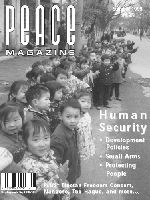
Peace Magazine Summer 1999, page 29. Some rights reserved.
Search for other articles by Ken Simons here
Edited by Peter Brock and Thomas B. Socknat. University of Toronto Press 1999, $75.00
Some of us felt isolated during the NATO bombing campaign and the Serbian ethnic cleansing campaign against the Kosovars. The anti-war movement largely condemned the NATO bombing without equally condemnating the Milosevic regime's long list of war crimes.
When your own country is involved in a one-sided bombing campaign, with little concern for civilian casualties, many people understand their duty to protest against the abuses being committed in their name - not against the abuses committed by the other side. But this often comes close to glorifying the other side's militarism.
We've been here before. The authors in Challenge to Mars look at the moral and ethical problems facing pacifists - mainly in northern Europe and the anglophone countries, but including Russia, India, and Japan - as World War II loomed. Today's movement can learn much about our relationship to state power and to individuals' acts of conscience.
Andrew Rigby examines the record of one large anti-war movement, Britain's Peace Pledge Union. The year is 1938, and the Munich accord is up for discussion: In arguing that Germany had legitimate grievances, in suggesting that it was hypocritical for Britain to condemn Germany in the light of Britain's acts of conquest and repression in India and elsewhere, correspondents and writers in Peace News [at the time, the PPU's weekly newspaper] sometimes disregarded the fate of people and countries threatened by Nazi Germany.
Meanwhile, in France, the greatest tensions were over the linkages between pacifism, human rights, and anti-fascism. The Ligue des Droits de l'Homme et du Citoyen, an influential forum for radical republican opinion, saw a fierce power struggle between old-style League of Nations pacifists and new-style total pacifism, which advocated unilateral disarmament. The old guard won; but the total pacifists had a view of the coming war which was more nuanced than it appeared at first. Félicien Challaye, who had argued the total pacifist position within the Ligue, as Norman Ingram notes, emphasized that the minority condemned the Nazis' racist "persecution of communists, socialists, pacifists and Jews, as much as did the majority. But he took the position that opposition to an internal regime must not serve as pretext for creating a war psychosis."
The experience of German pacifists is detailed in two chapters. Revealingly, perhaps, there is very little overlap of experience between the organized pacifist movements of the Weimar Republic and the personal, often Christian-based, and usually tragic, resistance to military service under Hitler. The story of Austrian farmer and conscientious objector Franz Jägersttter - beheaded in 1943 - is now fairly well-known, thanks to of Pax Christi and other Catholic pacifists. Others, like the mechanic Albert Herbst, also executed in 1943, came to their pacifism through private study and reflection, without the support of their churches or communities.
Unlike the Weimar-era pacifists, these German and Austrian war resisters were mainly from peasant or working-class backgrounds. There was no real continuity between the pre-war movement and the wartime resistance.
This discontinuity was seen elsewhere as well - even in countries like Canada, where most conscientious objectors detained during wartime were from religious communities, such as the Mennonites and the Jehovah's Witnesses, which had little connection with secular pacifism.
One way in which pacifists have dealt with war in their own countries has been by nonviolent support of the persecuted to guarantee their safety and strengthen a community of resistance amidst war. The story of Le Chambon-sur-Lignon, a Protestant village which sheltered Jewish refugees in defiance of the pro-Nazi Vichy regime, is retold in a chapter on religious pacifism in France. Le Chambon's parallel today may be the Decani monastery in Kosovo, which sheltered Albanians during the Serbian ethnic cleansing and now shelters Serbs - with the approval of returning Albanians, who respect the monks' pacifism and refusal to be intimidated.
Peace Magazine office manager Ken Simons is a former editor of Peace News.

Peace Magazine Summer 1999, page 29. Some rights reserved.
Search for other articles by Ken Simons here